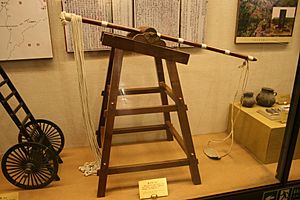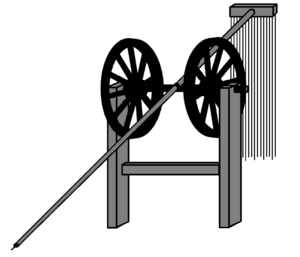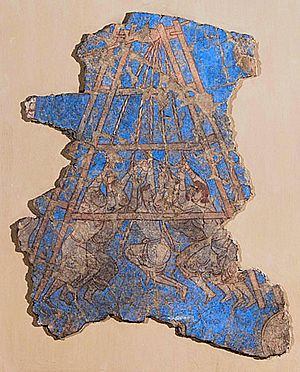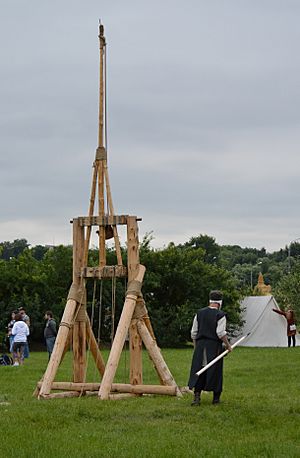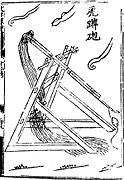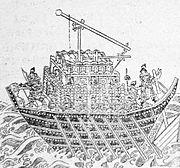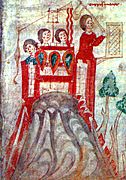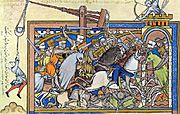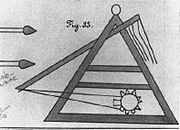Mangonel facts for kids
The mangonel, also called the traction trebuchet, was a type of trebuchet used in Ancient China starting from the Warring States period, and later across Eurasia by the 6th century AD. Unlike the later counterweight trebuchet, the mangonel operated on manpower pulling cords attached to a lever and sling to launch projectiles.
Although the mangonel required more men to function, it was also less complex and faster to reload than the torsion-powered onager which it replaced in early Medieval Europe. It was replaced as the primary siege weapon in the 12th and 13th centuries by the counterweight trebuchet. A common misconception about the mangonel is that it was a torsion siege engine.
Etymology
Mangonel is probably derived from the Greek mangana, "a generic term for construction machinery." It could also be derived from mangon, a French hard stone found in the south of France. In Latin it is called a manganum, in French a manganeau, and in English a mangonel. Mangonel was a general term for medieval stone-throwing artillery and used more specifically to refer to manually (traction-) powered weapons. It is sometimes wrongly used to refer to the onager. Modern military historians came up with the term "traction trebuchet" to distinguish it from previous torsion machines such as the onager.
The mangonel was called al-manjanīq, arrada, shaytani, or sultani in Arabic. In China the mangonel was called the pào (砲).
History
China

The mangonel is thought to have originated in ancient China. They were probably used as early as 4th century BC.
According to the Mojing, the mangonel was 5.2 metres (17 ft) high with four feet buried below ground, the fulcrum attached was constructed from the wheels of a cart, the throwing arm was 9.1 to 10.7 metres (30 to 35 ft) long with three quarters above the pivot and a quarter below to which the ropes are attached, and the sling 80 centimetres (2 ft 8 in) long. The range given for projectiles are 90, 50, and 40 metres (300, 180, and 120 ft). They were used as defensive weapons stationed on walls and sometimes hurled hollowed out logs filled with burning charcoal to destroy enemy siege works.
In 617 Li Mi (Sui dynasty) constructed 300 mangonels for his assault on Luoyang, in 621 Li Shimin did the same at Luoyang, and onward into the Song dynasty when in 1161, mangonels operated by Song dynasty soldiers fired bombs of lime and sulphur against the ships of the Jin dynasty navy during the Battle of Caishi. During the Jingde period (1004-1007), many young men rose in office due to their military accomplishments, and one such man, Zhang Cun, was said to have possessed no knowledge except how to operate a Whirlwind mangonel. When the Jurchen Jin dynasty (1115–1234) laid siege to Kaifeng in 1126, they attacked with 5,000 mangonels.
Chinese mangonels
The Wujing Zongyao lists various types of the mangonel:
- Whirlwind - a swivel mangonel for shooting small missiles that could be turned to face any direction
- Whirlwind battery - five whirlwind mangonels combined on a single turntable
- Pao che (catapult cart) - a whirlwind mangonel on wheels
- Crouching tiger - medium sized mangonel considered stronger than the whirlwind type but weaker than the four-footed
- Four-footed - a trestle-frame mangonel for shooting heavier projectiles
- Two-seven component - different weight classes for the four-footed type indicated by the number of poles bound together to create the swinging arm
| Weapon | Crew | Projectile weight (kg) | Range (m) |
|---|---|---|---|
| Whirlwind | 50 (rotating) | 1.8 | 78 |
| Crouching tiger | 70 (rotating) | 7.25 | 78 |
| Four footed (one arm) | 40 (rotating) | 1.1 | 78 |
| Four footed (two arm) | 100 (rotating) | 11.3 | 120 |
| Four footed (five arm) | 157 (rotating) | 44.5 | 78 |
| Four footed (seven arm) | 250 (rotating) | 56.7 | 78 |
Spread
The mangonel was carried westward by the Avars and appeared next in the eastern Mediterranean by the late 6th century AD. According to the Miracles of Saint Demetrius, probably written around 620 by John, Archbishop of Thessaloniki, the Avaro-Slavs attacked Thessaloniki in 586 with mangonel. The bombardment lasted for hours, but the operators were inaccurate and most of the shots missed their target. When one stone did reach their target, it "demolished the top of the rampart down to the walkway."
The Byzantines adopted the mangonel possibly as early as 587, the Persians in the early 7th century, and the Arabs in the second half of the 7th century. Like the Chinese, by 653, the Arabs also had ship mounted mangonel.
The Franks and Saxons adopted the weapon in the 8th century. The Life of Louis the Pious contains the earliest western European reference to mangonels in its account of the siege of Tortosa (808–809). In the 890s, Abbo Cernuus described mango or manganaa used at the Siege of Paris (885–886) which had high posts, presumably meaning they used trebuchet-type throwing arms. In 1173, the Republic of Pisa tried to capture an island castle with mangonels on galleys. Mangonels were also used in India.
Function
The mangonel was most efficient as an anti-personnel weapon, used in a supportive position alongside archers and slingers.
Some exceptionally large and powerful mangonels have been described during the 11th century or later. At the Siege of Manzikert (1054), the Seljuks' initial siege artillery was countered by the defenders' own, which shot stones at the besieging machine. In response, the Seljuks constructed another one requiring 400 men to pull and threw stones weighing 20 kg. A breach was created on the first shot but the machine was burnt down by the defenders. According to Matthew of Edessa, this machine weighed 3,400 kg and caused a number of casualties to the city's defenders. Ibn al-Adim describes a mangonel capable of throwing a man in 1089. At the siege of Haizhou in 1161, a mangonel was reported to have had a range of 200 paces (over 400 meters).
Decline
West of China, the mangonel remained the primary siege engine until the late 12th century when it was replaced by the counterweight trebuchet. In China the mangonel was the primary siege engine until the counterweight trebuchet was introduced during the Mongol conquest of the Song dynasty in the 13th century.
-
Crouching tiger trebuchet (stationary mangonel) from the Wujing Zongyao
-
Five whirlwind trebuchets (swivel mangonels) from the Wujing Zongyao
-
Mangonel on a Song Dynasty warship from the Wujing Zongyao
-
Muslim mangonel, 1285
See also
 In Spanish: Mangana para niños
In Spanish: Mangana para niños


